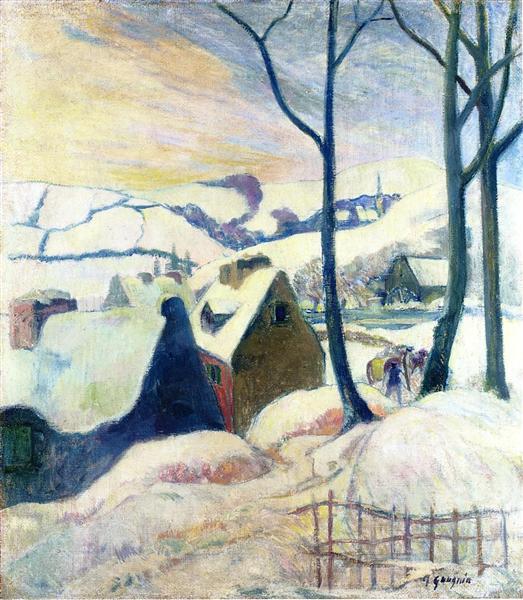תיאור
Paul Gauguin's painting Village in the Snow, created in 1894, falls during a period in his career when he was exploring a novel approach to color and composition. In this work, Gauguin depicts a small, seemingly isolated village covered in a thick white blanket of snow. The choice of snow as a setting provides a dramatic contrast to the warm color palette that typically characterizes his work. Gauguin's post-impressionist aesthetic is evident in his bold use of color and simplification of forms, in what could be considered a predilection for the ornamental and the symbolic.
The composition of Village in the Snow is notable for its orderly structure, where houses are aligned, forming an environment that evokes both serenity and solitude. The shapes of the buildings are simplified and geometric, a distinctive feature that recalls the influence of the works of the Pont-Aven School, of which Gauguin was a key member. The almost flat treatment of the elements, together with the oppressive atmosphere of the snowy landscape, resonates with the principles of symbolism, suggesting an emotional state rather than a faithful representation of reality.
Colour plays an essential role in the work. The shadows of the houses contrast with the pure white of the snow, while brushstrokes of subtly saturated colours on the roofs and details of the facades add a touch of warmth that invites the viewer to reflect on the life hidden behind these structures. The atmosphere of the work is imbued with a sense of stillness and, at the same time, an unrevealed secret, perhaps Gauguin's reflection on his own feelings towards nature and culture.
Unlike many works of its time, Village in the Snow lacks any obvious human presence. This absence can be interpreted in several ways: it could reflect Gauguin's search for a deeper connection with nature, or it could be a meditation on human loneliness and isolation in a desolate environment. This lack of interest in the human figure in a landscape context is found in other works by Gauguin and links it to the romantic perception of rural life.
Stylistically, Gauguin was already beginning to distance himself from traditional Impressionism, becoming increasingly interested in symbolism and the exploration of what he called "primitive art." His focus on the essence of forms and the expressive power of color helped open the door to later movements such as Fauvism and Expressionism. This work, along with others from its time, reaffirms his role as a precursor of modernism in art.
In conclusion, Village in the Snow is a work that encapsulates Gauguin's uniqueness, his ability to transform a seemingly simple landscape into a vibrant study of solitude, culture and color. This painting stands out not only for its charming visual simplicity but also for the complex emotions and meanings it suggests, inviting the viewer to a deep introspection about the relationship between human beings and their environment. The choice of winter, the use of space and color, frame a work that is more than a mere portrait of a village; it is a dialogue between art and human feelings, inextricable from the very experience of life.
KUADROS ©, a famous painting on your wall.
Hand-made oil painting reproductions, with the quality of professional artists and the distinctive seal of KUADROS ©.
Painting reproduction service with satisfaction guarantee. If you are not completely satisfied with the replica of your painting, we will refund 100% of your money.

